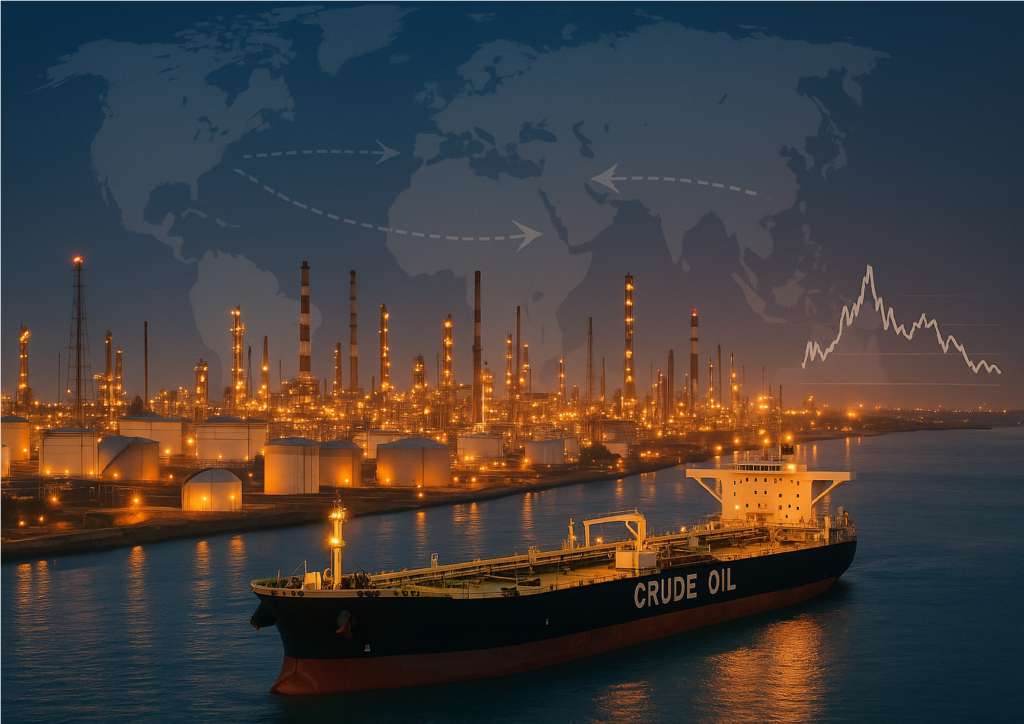
- From a minimal capacity in the 1990s, India became the world’s third-largest refiner with 254 MTPA by 2023, driven by massive public and private investments.
- After the Ukraine war, India became Russia’s second-largest oil buyer, importing over 1.7 million bpd in 2023 and exporting refined products globally, including to sanctioning countries.
- By absorbing discounted Russian crude, India helped moderate global oil prices from $120 to $70–90 per barrel, easing global inflation while keeping domestic inflation at 5–6%.
- Strategic autonomy in energy trade boosted refining margins, contributed ₹7.5 lakh crore in revenues, and strengthened India’s influence in the Global South with investments from Saudi Aramco and ADNOC.
India has made a significant stride in the last two decades in becoming one of the largest oil refining hubs in the world. From the construction of massive coastal refineries at Jamnagar and Paradip to the expansion of state-owned refining capacity, India has advanced from energy concerns in the 1990s to establishing itself as a pivotal player in the global oil trade. But things changed overnight after the Russian invasion of Ukraine in February 2022. Western sanctions and price caps on Russian crude redirected vast quantities of discounted oil to Asian markets, with India having the capacity and capability to refine crude into diesel, petrol and aviation fuel and then export products even to sanctioning countries, creating an “energy arbitrage” that had far-reaching consequences. And this could be a plausible cause that led Donald Trump to levy tariffs on India.
This essay argues that India’s refining rise, turbocharged by Russian crude imports, not only helped moderate global energy inflation but also gave India an important instrument to balance its geopolitics. Post-pandemic, it was a very difficult task to stabilise domestic inflation and ensure affordable energy. However, the Russia-Ukraine war proved to be a blessing for India, which allowed New Delhi to import oil at a lower price and manage domestic inflation. Perhaps this has irked Donald Trump, who now has to deal with a confident India that is unafraid of his tariffs.
Historical context
Until the 1990s, India’s refining capacity was abysmal. We could not even fulfil domestic consumption, forcing imports of both crude and refined products that had a huge impact on our exchequer. However, the economic liberalisation that was started in 1991 allowed the government to shift towards large-scale refining investments. By 2023, India had about 254 Million Tonnes Per Annum (MTPA) of refining capacity, equivalent to around 5 million bpd, behind the US and China. State-owned Indian Oil Corporation alone operates 11 refineries with 80 MTPA capacity, while Reliance and Nayara (backed by Rosneft) add significant private-sector muscle.
Competitive Advantages
India’s geography gives it a unique advantage, and over the years, India’s coastal refineries have been strategically placed near shipping lanes, making them export-oriented hubs. Indian refineries, particularly Jamnagar, are highly complex, capable of processing heavy and sour crudes, which allows them to absorb discounted Russian Urals. India’s location enables exports to both Atlantic and Asia-Pacific markets, creating a unique bridging role. Unlike China, India has no Malacca Strait bottleneck. Thus, before the Ukraine war, India had already become the world’s third-largest refiner with ambitions to expand to 450 MTPA by 2030.
The Russian Oil Windfall
After Russia invaded Ukraine, the West imposed sanctions and restricted Russia’s ability to sell crude above a $60 price cap. Europe, traditionally the biggest buyer of Russian Urals, cut imports dramatically. This left Moscow dependent on willing buyers, mainly China and India. India, which had imported negligible Russian crude in 2021 (less than 2% of total imports), suddenly became Russia’s second-largest customer after China, with imports surging to over 1.7 million bpd by mid-2023.
The sudden stoppage of oil immediately would have triggered an energy crisis, mass inflation and political backlash. So the West needed India to keep Russian oil flowing into the global market so that prices didn’t skyrocket globally. India was encouraged to buy Russian crude. Whenever oil prices cross $90 per barrel, it leads to inflation and possible recession. However, the US now wants India to buy oil and gas from it, which does not suit India’s cost arbitrage.
Refining Arbitrage
Indian refiners purchased Russian Urals and ESPO (Eastern Siberia–Pacific Ocean) grades at discounts of $20–30 per barrel compared to Brent. This crude was then refined into diesel, petrol, aviation turbine fuel and liquefied petroleum gas (LPG), which were exported globally, often to Europe. By 2023, India had become one of the largest exporters of refined petroleum products to Europe, effectively recycling Russian oil through its refineries.
The Russian windfall boosted refining margin, i.e. the difference between crude cost and product prices, to record highs. For Reliance, margins on petrol and diesel exports soared, making Jamnagar a profit engine. State-owned refiners, traditionally under pressure due to price caps on domestic sales, also saw windfall profits from exports. But more importantly, the central government in the financial year 2023–24 received an estimated ₹4.32 lakh crore from the petroleum sector, with about ₹2.73 lakh crore coming solely from excise duties. Adding in state government revenues (₹3.19 lakh crore), the overall sector contribution was approximately ₹7.5 lakh crore.
Impact on Global Inflation
In 2022, crude oil prices spiked to over $120 per barrel, driving fears of global stagflation. However, by 2023–24, prices moderated to the $70–90 range. A key factor was the diversion of Russian crude to India and China, ensuring supply continuity despite sanctions. Without this redirection, global markets would have faced a supply shortfall of around 2 million bpd, pushing prices much higher.
Saudi Arabia was historically one of India’s biggest oil suppliers (along with Iraq). But in 2022, Russia overtook Saudi Arabia as India’s largest oil supplier, offering crude at heavy discounts (often $20–30 cheaper per barrel than Brent). But much to the dismay of the West, Riyadh understood the reality that India is buying cheap Russian oil for economic reasons. Instead of confrontation, the Saudis have been offering flexible pricing and long-term contracts to retain some share. Also, since Saudi Arabia and Russia are both part of the OPEC+ alignment, it doesn’t want to alienate Moscow by pressuring India directly. Saudi Arabia instead chose strategic patience because Russian discounted oil can’t last forever, and when sanctions ease, India will likely rebalance imports.
Breaking The Inflation Spiral
The IMF and International Energy Agency (IEA) noted that alternative buyers of Russian crude by India helped prevent a full-scale energy price shock. This had a knock-on effect on global inflation, which peaked in 2022 but declined faster than feared in 2023–24. India’s inflation in 2022–23 averaged around 5–6%, far lower than double-digit rates in Europe. Cheap Russian crude allowed refiners to reduce their cost base. Even with government excise duties, the landed cost of fuel remained lower than it would have been with Middle Eastern or US crude.
Lower import costs reduced the subsidy burden for LPG and kerosene, easing fiscal pressures. For state-owned oil marketing companies, the Russian arbitrage converted losses into profits. This gave the Modi government room to fund many social programmes without large deficits. Affordable diesel kept logistics costs manageable, cushioning India’s manufacturing and agriculture from cost-push inflation. This helped maintain GDP growth above 6%, making India the fastest-growing economy in the world.
Geopolitical Leverage from Refining Power
India’s ability to buy Russian crude despite Western pressure demonstrated its “strategic autonomy.” New Delhi balanced relations with Moscow while avoiding direct sanctions breaches, proving its economy can defy Western dictates. Ironically, Indian refiners exported Russian-origin fuels back to Europe, highlighting Europe’s dependence on India despite its sanctions rhetoric. This gave New Delhi quite a leverage in trade and diplomatic negotiations. The trade deal with the United Kingdom is proof.
By showing that it could secure discounted energy, stabilise inflation and still engage multilaterally, India is now the ideal model for the Global South. Saudi Aramco and ADNOC invested in Indian refineries, recognising that India was no longer just a consumer market but a refining-export platform. This has further integrated India into global energy diplomacy, no longer bullied by the energy-rich.
America accuses India of importing oil from an authoritarian regime, but conveniently forgets that for decades, the US imported oil from Saudi Arabia, a country not known for its democratic credentials. In fact, it changed a duly elected democratic government in Iran in 1953 because Prime Minister Mohammad Mosaddegh wanted to nationalise the oil industry, and now it is hell-bent on regime change again in Iran.
It is strange that India, a country not known for its hydrocarbon reserves, has managed to turn the tide of energy politics by becoming a leading player in oil refining. What one must know is that when oil is refined, it also leads to various by-products which are crucial for running the global industry, and India has the grease. What the US will now find difficult is that India’s influence in the Global South will only increase, and Africa and South America are resource-rich.
India’s rise as one of the world’s largest refiners reflects decades of investment and strategic foresight. The Ukraine war and sanctions on Russian crude have made India a refining power. By absorbing discounted Russian oil, refining it and exporting products, India not only secured cheap energy for itself but also prevented a deeper global inflationary spiral. This dual role of domestic stabiliser and global shock absorber translates into significant geopolitical leverage for India.
References
- https://m.economictimes.com/industry/energy/oil-gas/the-worlds-last-wave-of-oil-refining-bets-all-about-india/articleshow/107279995.cms
- https://www.reuters.com/markets/commodities/india-shaping-up-refining-hub-rely-fossil-fuels-until-2040-oil-minister-says-2024-11-12
- https://www.eia.gov/international/content/analysis/countries_long/india
- https://www.reuters.com/markets/commodities/indias-russian-oil-imports-surge-record-january-trade-2023-02-17
- https://indiatimes.com/trending/donald-trump-warns-india-on-massive-russian-oil-buys-signals-substantial-tariff-hike-what-could-that-mean-for-trade-665883.html
- https://www.business-standard.com/economy/news/excise-duty-collections-from-petroleum-sector-decline-4-8-in-fy24-124081601531_1.html
- https://economictimes.indiatimes.com/news/economy/foreign-trade/over-20-of-russias-war-period-crude-exports-bought-by-india-crea/articleshow/123438611.cms
- https://www.ft.com/content/dfba92c3-523a-41b2-b940-d10c2ccb340e
- https://climatestrategies.org/wp-content/uploads/2023/04/Russian-Oil-and-Gas-One-Year-of-War-Reverses-Decades-of-Energy-Diplomacy_v2.pdf
- https://timesofindia.indiatimes.com/business/india-business/india-faces-911-billion-oil-bill-spike-forced-pivot-from-russian-crude-after-trumps-penalty-could-hit-margins-analysts-warn-of-inflation-risks/articleshow/123071591.cms
- https://www.politico.com/news/2025/08/06/us-to-hike-tariffs-on-india-to-50-percent-over-russian-oil-purchases-00495411
- https://timesofindia.indiatimes.com/business/india-business/they-are-just-profiteering-trump-administration-fires-fresh-salvo-on-india-for-russia-crude-trade-made-16-billion-in-excess-profits/articleshow/123389969.cms
Balaji is a freelance writer with an MA in History and Political science and has published articles on defence and strategic affairs and book reviews. He tweets @LaxmanShriram78. Views expressed are the author’s own.
